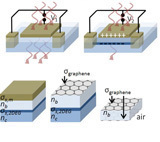
A team of University of Notre Dame researchers has harnessed graphene to control the terahertz portion of the electromagnetic spectrum.
Researchers are increasingly interested in terahertz radiation because it offers the possibility of new technologies in communications, medical imaging and chemical detection. However, terahertz waves, which are located between the lowest energy infrared light and the highest energy radio waves, are notoriously hard to produce, detect and modulate. Modulation, which involves varying the height of the terahertz waves, is an especially important property because a modulated signal can carry information and is versatile enough for applications in fields such as chemical and biological sensing.
Much of the current state of terahertz technology relies on small structures similar to semiconductor transistors which can modulate a terahertz signal at room temperature. This is a significant improvement over earlier modulators which could only operate at extremely cold temperatures.
However, the current generation of broadband terahertz modulators uses a thin layer of metal called a “metal gate” for use in tuning the terahertz signal. The use of a metal gate significantly reduces signal strength and limits signal modulation to less than 30 percent.
The Notre Dame group reported that replacing the metal gate with a single layer of graphene would expand the modulation range to more than 90 percent. Graphene has a number of desirable properties, including being a good conductor of electricity, superb thermal insulation and remarkable strength. The Notre Dame research finding potentially is a significant step in ushering in new terahertz technologies.
The research is described in the journal Applied Physics Letters. The team, consisting of researchers from the University’s Department of Electrical Engineering and its Advanced Diagnostics and Therapeutics initiative, including lead author Berardi Sensale-Rodriguez, Tian Fang, Rusen Yan, Michelle M. Kelly, Debdeep Jena, Lei Liu and Huili (Grace) Xing.
Contact: Berardi Sensale-Rodriguez, berardi.sensalerodriguez.1@nd.edu; Huili (Grace) Xing, hxing@nd.edu